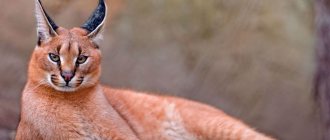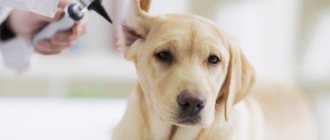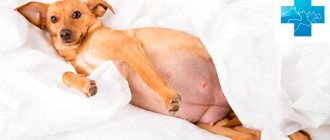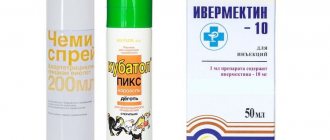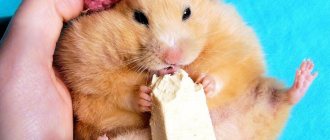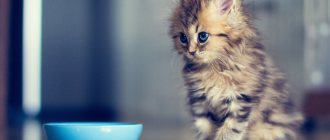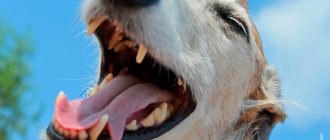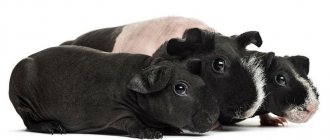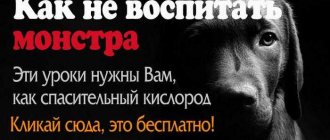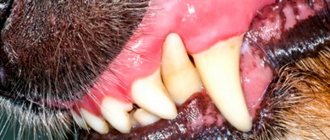Description of pets
The Shiba Inu is considered a national treasure of Japan; the name of the breed means “small dog . This is a hunting breed, initially the Shiba was even used for baiting large animals.
Representatives of the breed are distinguished by their expressive appearance, characteristic of the Japanese. This is a small, strong-built dog with a muzzle that resembles a fox.
The Shiba Inu's skull is wide, with a clear transition from the forehead to the muzzle . The muzzle tapers towards the nose, forming a characteristic attractive smile.
Shiba Inu are the smallest of the six native Japanese breeds.
Other distinctive external features of the breed are:
- wide strong back;
- compact powerful paws;
- a high-set tail, most often wrapped in a ring;
- erect triangular ears;
- slanted, expressive brown eyes;
- strong neck of medium length and width;
- three-layer thick dense wool, the undercoat is soft, the main layer is straight and hard;
- The most common color is red.
The Shiba Inu is characterized by good intellectual qualities, such as thoughtfulness, a tendency to learn, developed hunting instincts, and excellent psychological adaptability.
NOTE!
Representatives of the breed are quite willful, but do not show excessive aggression without reason and get along well with children.
The breed is more suitable for experienced owners who love and know how to competently conduct classes and training with a dog..
Shiba Inu: description
The Shiba Inu breed belongs to the category of medium-sized dogs. Her height at the withers reaches a maximum of 41 cm, and her weight is within 11 kilograms on average. As a rule, males are larger (20 percent) compared to females. Despite its not so impressive size, the breed is quite strong and courageous.
The main color of the breed can be very diverse, but the muzzle area should always stand out in the form of a mask, while having a lighter color. It is believed that the main difference between the breed is the special expression of its muzzle, which creates the impression of a peculiar smile. This unique facial expression makes this breed more attractive, especially since this facial expression is very compatible with its cheerful and independent behavior.
And yet, despite such a good-natured appearance, the dog is created for serious challenges, which is due to its powerful and well-developed jaws with an ideal bite. In addition, the dog has medium-length and strong paws, as well as a muscular and strong, proportionally built body. Therefore, we can safely say that the breed was created specifically for hunting.
Breed standards
World breed standards allow the following main colors of the breed: red, black and tan, sesame, various combinations of white, black and red shades. The main effort of purity of the standards relates to the color of the muzzle area, which should be significantly lighter. Completely white specimens are quite rare, but the color is considered the most spectacular, although they are not allowed to participate in exhibitions. In fact, it is believed that this color is a sign of degeneration of the breed.
The dog's tail is of medium thickness, which is curled in the shape of a sickle or a steep ring. The eyes are relatively small, although slightly slanted. The ears, although erect, have a slight tilt forward. The nature of the coat is hard, with a thick and dense undercoat, making Shiba Inu puppies more like plush toys.
Shiba Inu Behavioral Character
This breed has a rather stubborn and independent character, so it is often considered a stupid breed, but this is due to the ignorance and irresponsibility of some owners. In fact, everything is completely different, since the animal knows its worth and demands appropriate attention and respect. They are reluctant to train, so it is practically impossible to do without a specialist.
If you show a lot of patience and perseverance, the result will not keep you waiting long. In addition to high intelligence, many experts note that the dog has cunning and cunning, although this is typical for individual specimens. Dogs do not show aggression towards strangers, but behave with restraint, although they can even play, and it all depends on their mood.
The problem is that the dog does not get along well with other pets. As a rule, this fact only indicates that the dog has very highly developed hunting instincts, as well as protective instincts, since Shiba Inu are very jealous of protecting their territory.
It is important to know! The dog also has a rather strained relationship with children, but if you explain to the children how to behave with this dog, then there should be no problems.
In addition, these are quite active and cheerful pets that do not show aggression towards humans. In fact, owners of this breed should not relax, as difficulties often arise with the dog's behavior. Quite often it happens that owners cannot cope with the character of the Shiba Inu and abandon the dog. At best, she can be taken to a shelter.
How long do they live?
The advantage of the breed is that it has virtually no hereditary diseases that could significantly shorten the animal’s life expectancy. Proper care and proper nutrition, as well as regular examinations by a specialist, can provide the animal with a healthy lifestyle for a maximum of 15 years.
Important fact! There is an officially registered case in which a Shiba Inu dog lived for 18 years.
As a rule, the longevity ceiling is around 16 years, which is quite impressive for this breed. Shiba Inu dogs remain active throughout their lives.
Shiba Inu. Japanese dog breed
Origin story
According to archaeological excavations, the breed has existed for more than 2,500 years..
The breed has been widespread in rural areas of Japan since ancient times. Dogs were used to hunt small game, as well as wild boar, deer and even bears.
The breed standard was approved in Japan in 1934, in the middle of the 20th century the breed was on the verge of extinction, however, thanks to the efforts of Japanese breeders, the population was saved and now the Shiba Inu is recognized by all world canine organizations.
The breed came to Russia in the 90s and is now in unprecedented demand.
History of the breed
During excavations on the Ainami Islands in Japan, ceramic figurines were found that were shaped like Shiba Inu dogs; these finds date back to the 3rd century BC, made during the time of the resettlement of Koreans to the islands of Japan. According to experts, it was the Koreans who brought the ancestors of these wonderful dogs with them to help them hunt wild animals.
As new settlers (Ainu) took root in a new place, the formation of the breed occurred as a result of crossing with domesticated aboriginal dogs and wolves. In the mid-19th century , after the lifting of Japan's self-isolation, Europeans began to actively import other dog breeds into the country, as a result of which there was active crossing of breeds and by 1926 the Shiba Inu breed was considered almost extinct .
Closer to 1928, the question of restoring the breed was raised . The government created the Canine Association for the Preservation of the Dog Population (Nippo). The list of protection included the following breeds: Akita Inu, Kai, Shikoku Hokaido, Kishu, and including Shiba Inu. In 1934 - 1935, it was possible to restore most of all indigenous breeds , as a result, a large Shiba Inu population was formed, and the breed itself became a property of Japanese history.
During the Second World War, as a result of tragic events, a large number of dog kennels were damaged, later followed by an outbreak of distemper, which put the population at risk . The variety of breed varieties before and after the war was very different; if previously there were more than a dozen varieties , then after them there were only three types:
- mino (most similar)
- shin-shu (slight difference in color and type of undercoat)
- san-in (slightly larger than his brothers)
In the 80s, the Inu breed began to gain popularity abroad, especially in European countries and the United States, and closer to 1992, the breed was officially recognized by the AKC dog handlers associations in America. Today, Shiba Inu dogs are increasingly becoming good and kind companions to their owners, showing their temperament and hunting disposition , demonstrating it in practice.
Character traits
The main character traits of the Shiba Inu include the following::
- courage;
- independence;
- self confidence;
- good manners;
- devotion.
If the owner managed to establish friendly and companionate relationships with the pet, then the dog will respond with love and devotion. At the same time, she is independent; the owner must have a strong spirit in order to earn the respect of a Shiba.
Representatives of the breed are quite active and playful, we must also not forget about their natural hunting instincts, they are well developed, so puppies require early socialization.
Expert opinion
Kozhevin Semyon Kirillovich
Expert dog handler.
“This is an extraordinary breed; you fall in love with them from the moment you meet them. Shiba Inus are affectionate and loyal. But they need to be given a lot of attention, care, and must be educated from an early age. To avoid excessive aggression, it is important to properly train your pet and socialize it on time. It should be noted that they are quite hardy, love snow and, thanks to their rich fur coat, tolerate the cold well and can live in an enclosure.”
Pet character
Shiba Inus have a difficult character , which not everyone can cope with .
These dogs are stubborn and independent, which can seriously complicate the process of education and training - if the pet does not want to do something, then it is almost impossible to persuade or force it.
To people unfamiliar with this breed, it may seem that Shiba Inus are gloomy, unsociable dogs that prefer to always be alone. This is not entirely true.
They really need peace and a place where they can hide from prying eyes, but at the same time they are devoted to their owner and love him, they are just not prone to strong displays of emotions.
Only a person with a strong, strong-willed character can become a master for a Shiba Inu, in whom he will see the leader of the pack, a leader.
At the same time, it is necessary to show the pet that he is not the main one in the house as early as possible, but in such a way as not to belittle his dignity: Shiba Inu only accept communication on equal terms and will not obey.
CAREFULLY!
Due to the preserved instincts used by these dogs in hunting, Shiba Inu are quite aggressive towards other animals and people; only early socialization can change this.
Representatives of this breed are good watchmen and security guards, they are active and hardy and will become good companions for people leading an active lifestyle.
Advantages and disadvantages
Like any other representative of the Japanese breed, the Shiba Inu is a difficult dog in character. Keeping it as a pet has its positive and negative aspects.
The advantages of the breed include the following::
- expressive and memorable appearance;
- extraordinary intelligence and insight;
- cleanliness;
- ease of care;
- agility and strength;
- devotion to the owner and love for children;
- compact sizes.
Among the disadvantages of representatives of the ancient Japanese breed, the following can be noted::
- stubborn willful character;
- difficult to train;
- are not flexible and helpful;
- do not get along well with other dogs and pets.
It is worth taking note of the fact that the negative aspects of keeping a Shiba Inu can be corrected through early socialization and proper training.
Socialization
Shiba Inu puppies are actively socialized from 2.5 to 7 months. At this time, the pet should receive as many new experiences as possible, learn to interact adequately with the outside world, and calmly communicate with strangers and other dogs. An animal’s bad habits acquired in childhood will be very difficult to correct in the future.
A pet Shiba Inu cannot be hit. The worst punishment is short-term isolation in a separate room with absolutely nothing to do.
Shiba Inu and children quickly become fast friends. The pet perceives a small child as an equal. But a dog is not a toy. The animal will not tolerate disrespectful treatment.
With teenagers, the Mina Akita will happily run around in the fresh air, splashing out its pent-up energy.
A mini Akita and a cat will get along if they met as children. Otherwise, clashes between animals for the dominant position in the pack are possible. However, most often cohabitation proceeds calmly - on the Internet you can find many photos of a Shiba Inu dog and a representative of the feline sleeping or playing together. The situation is somewhat more complicated with other pets. The Shiba dog does not like birds and small rodents - the hunting instinct makes itself felt.
Color variations – which colors are the most popular?
The most popular and standard accepted Shiba Inu colors are the following::
- black and tan;
- ginger;
- sesame.
The most common and preferred color is red . There are also black sesame (there are more black hairs than white ones) and red sesame (a combination of red and black hairs with a predominance of red).
According to the standard, any dark-colored representatives of the breed must have light markings called “urazhiro” . It covers the cheekbones, throat, lower neck, chest and abdomen, inner surface of the limbs and the bottom of the tail.
There are also completely white Shiba Inus, they look very attractive, but they are suitable only as a pet; they will not be able to participate in exhibitions or breed with them.
Distinctive features
Shibs are small dogs, reaching 36-39 cm at the withers. There are the smallest representatives, whose height is no more than 30 cm. They are not included in the standard, but are considered pretty pets.
One way or another, all dogs must meet certain proportions. Their format is almost square, the body length to height ratio is 110 to 100. The dogs have a fit, well-built body, which allows them to develop high speed and hunt large animals.
The standard was last revised in 1995. There are 2 variations - FCI (worldwide) and Nippo (Japanese). In general, they are not very different, but the first one is more detailed and pays attention to all the details.
- The head is wide, wedge-shaped, with clearly defined stops and cheekbones (cute cheeks are formed).
- The muzzle is not wide, pointed (foxy). The bridge of the nose is straight. The jaw is strong with a full set of teeth and a scissor bite (the upper teeth overlap the lower teeth). The lips are thin, well pigmented black.
- The nose is large and black.
- The eyes are small, slanted, set at stop level. The color of the iris is dark brown.
- The ears are set high, stand firm, slightly tilted forward. Triangular in shape.
- The body is slightly stretched, well built, strong and flexible. The back is long, the loin is wide, the croup is straight. The chest is well let down (50% of height), deep with rounded ribs. The neck is short, wide and muscular.
- The tail is long, thick, strong, curled into a ring.
- Limbs straight and parallel, proportional to the body. The paws are round with pointed toes. The movements are light and energetic.
- The coat is medium length, fluffy, hard, straight. The undercoat is thick and soft. The hair on the tail and body is longer than on the limbs and muzzle.
- Colors: red, black, sesame (a mixture of red and black-brown). There should be “urajiro” - lightened hair on the chest, cheeks, muzzle, under the tail, on the limbs.
Nutritional features - how to feed correctly?
Experts advise feeding Shiba Inu with ready-made food intended for this breed, since the food we are used to can cause allergies in a representative of the Japanese breed.
It is best if the food contains one type of protein . Salmon and rice based diets are popular for the breed.
The dog owner can choose natural feeding, but it is important to understand that the pet needs a balanced diet containing the required amount of proteins, fats and carbohydrates, as well as minerals.
Sea fish in the Shiba Inu's diet, such as salmon or tuna, are ideal as a source of protein and healthy fats..
Meat dishes include lamb, duck, veal, rabbit, turkey, and beef. Rice or buckwheat porridge is suitable as a side dish. If there is no allergy, your pet can be given low-fat fermented milk products.
The following products are strictly prohibited:
- fat meat;
- smoked meats;
- sweets, chocolate;
- citrus;
- legumes;
- River fish;
- nuts;
- tubular bones of birds;
- grapes, raisins.
The number of feedings for an adult dog over 1 year old is 2 times a day, morning and evening, the serving size depends on the body weight, age and physiological characteristics of the pet.
Who to choose - a boy or a girl?
decide on the desired gender of your Shiba Inu puppy before purchasing it . Males and females have some differences in character, their advantages and disadvantages.
Thus, buying a male dog eliminates the possibility of encountering problems such as estrus, childbirth and false pregnancy. Boys' security qualities are more pronounced; they are bolder and more desperate.
In addition, the cost of males is lower. At the same time, male dogs react year-round to any female dog in heat, react aggressively to other male dogs and tend to start fights.
Bitches are more gentle and affectionate, they are more obedient, they become more attached to their owner, they get along better with children, becoming good nannies for them..
But estrus, which occurs 1-2 times a year, provokes some changes in the behavior of dogs: they become disobedient, nervous, and can show aggression.
To breed the breed, it is better to purchase a bitch - you can breed almost any dog, the main thing is that she has the necessary documents and an exhibition score of at least 4.5 points.
Health and major diseases, life expectancy
The average life expectancy of a Shiba Inu is 13-16 years..
Representatives of the breed are distinguished by good health, and many of them are long-lived. Japanese breeds have always been famous for their endurance and resistance to various diseases.
However, there is still a small list of diseases to which Shiba Inu are hereditarily predisposed.
The main health problems include the following:
- eye diseases;
- allergy;
- joint diseases;
- shortened spine;
- dislocation of the kneecap.
It is necessary to approach the choice of a pet with full responsibility to exclude congenital diseases that are practically untreatable.
Breed description and photo
The international standard corresponds to a specific description of the Shiba Inu breed.
- Country: Japan.
- Purpose: hunting, nowadays often a companion dog.
- Size: small of the medium sized breeds.
- Height: at the withers 35-40 cm.
- Weight: 7-13 kg (males – more, females – less).
- Color: only three standard options: red, black and tan, and also zonal (sesame, sesame, has an uneven distribution of pigment). The most common is red. Outside the standard, the color is more varied.
- Wool: the undercoat is short and soft, the topcoat is coarse, longer than the undercoat.
- Body: strong, muscular. The back is flat and wide. The dog is proportionally built.
- Paws: strong, strong. The front ones are slightly inclined, the toes are closely spaced. The hindquarters are well developed, the upper part is larger than the lower part.
- Tail: thick, curled into a donut, with long bristling hair, set high.
- Head: wide pointed muzzle, wide forehead, developed cheeks, moderately developed cheekbones, dense lips, scissor bite.
- Ears: triangular, small, protruding forward.
- Eyes: brown, triangular, small in size.
- Nose: black with open nostrils.
- Life expectancy: 13-16 years.
- Litter: 1-3 puppies (usually 3).
Did you know? Shiba Inu are caring mothers, but they raise puppies very strictly: if the baby is naughty, they press it to the ground with their teeth and hold it tightly until it calms down.
Dog sizes
The size of the Shiba Inu varies slightly depending on gender. Girls look smaller and slimmer.
Data on the main parameters of the breed are presented in table form:
| Gender of the dog | Height at withers, cm | Weight, kg |
| Bitches | 35,5-38,5 | 8-13 |
| Males | 38,5-41,5 | 9-14 |
Breed characteristics
| Short description | |
| Origin: | Japan |
| Conditions of detention: | Apartment, house |
| Purpose: | Hunting dog, companion dog |
| Color: | Shades of red with white tan |
| Wool length: | Average |
| Adult dog size: | The height of the female is 36.5 cm, the height of the male is 39.5 cm; male weight – 10-13 kg, female weight – 7-9 kg |
| Average life expectancy: | 12-15 years |
| Walk: | Walking twice a day is required |
| Physical activity needs: | High physical activity needs (regular frequent training for 2-3 hours) |
| Fédération Cynologique Internationale (FIC) classification: | Group 5: Spitz and primitive breeds, section 5: Asian Spitz and related breeds |
| Puppy price: | From 20,000 to 150,000 rubles. Without pedigree - from 20,000 rubles, pet class - from 35,000 rubles, breed class - from 50,000 rubles, show class - from 90,000 rubles |
Education and training
First of all, as soon as the pet crosses the threshold of the owner’s house, it is important to begin the process of education and socialization.
To begin with, you should accustom the dog to yourself, demonstrating your leadership qualities, but at the same time a kind attitude towards the dog, and then improve relationships with other family members.
From an early age, it is imperative to accustom the dog to his name , leash, toilet and rules of behavior in the house .
The simplest commands, such as “sit”, “come to me”, “place”, can be learned immediately, but full-fledged training should begin at the age of 3-4 months.
To successfully train a Shiba Inu, it is important for the owner to adhere to the following rules:
- ensuring regularity of classes;
- ensuring regular physical activity;
- friendly companionship towards the dog;
- rewarding the dog after a successfully completed command.
CAREFULLY!
Under no circumstances should you beat a dog; the proud nature of the Shiba Inu will not forgive the owner for such punishment.
Learning ability
The Shiba Inu's intelligence knows no bounds. The dog is incredibly cunning and tends to come up with its own solutions when trained. If you need a companion who unquestioningly obeys commands without hesitation, do not buy a Shiba. This dog evaluates the situation and does not tolerate mechanical exercises. To develop, it requires complexes of complex commands that require physical and mental effort.
The Shiba rarely shows emotions, but may harbor dissatisfaction. You should not use negative reinforcement in training; it is better to focus on praise. When training, do not perceive the dog as a decorative one - do not forget that it is a hunter by nature. And all the same, you are unlikely to achieve perfect obedience; do not expect this from your Shiba.
Smiling dog: breed. Shiba Inu (Shiba Inu): description of the breed
Features of care
Shiba Inu is perfect for keeping not only in an apartment, but also in an enclosure or in the yard.
If a decision is made to keep a pet in an apartment, then it is necessary to take care of constant walks and regular physical activity, otherwise the dog will behave incorrectly, destroying the home.
Representatives of the breed are distinguished by cleanliness and accuracy; they will never jump in puddles or get dirty in the mud, but they also require a clean, tidy home from the owner.
Otherwise, caring for the dog is simple, it includes several points:
- coat care (combing 3-4 times a week during shedding periods and once during the rest of the year);
- nail trimming (cutting once every 2 weeks);
- teeth cleaning (manipulation is carried out with a special brush once every 2-3 days);
- eye and ear care (regular wiping with a cotton pad soaked in a special solution for caring for dogs);
- bathing (it is enough to wash your pet once every six months or as needed).
The Shiba Inu needs its own corner of the house with a clear view..
Keeping a Shiba Inu at home
The conditions of an apartment are absolutely not suitable for keeping a Shiba Inu, but a country house with a large plot of land is what this animal needs. This is a physically developed breed, so you will have to take it on daily long walks, taxing the dog physically. If we talk about a regular walk on the site, which is suitable for other breeds of dogs, then it is not suitable for the Shiba Inu. Long runs or even bike rides are ideal for your pet.
Despite the fact that the Shiba Inu is not a large breed, it needs space, so a city apartment will be quite cramped for the animal. The breed has well-developed hunting and guarding instincts, so they become very attached to their territory. This fact indicates that a better watchman could hardly be found.
Naturally, the appearance of the animal is unlikely to scare away uninvited guests, but it will make a lot of noise, although the dog never barks unnecessarily. It is also necessary to take into account the fact that a dog can easily mistake smaller dogs, and even more so cats, for hunting.
In this case, it is very important to choose the time for walks in such a way as to minimize encounters with other animals. As a rule, this is typical for young, and not yet fully trained, dogs.
Care and hygiene
This breed is considered quite clean, because while on a walk the animal avoids puddles and generally tries not to get dirty. It is not necessary to wash them after a walk, but you will still have to clean them with a special brush. In addition, dogs lick themselves without any problems.
Important point! A pet needs to be combed once every 2 weeks, or even three, but during the molting process this procedure should be carried out more often - about every other day. This is due to the presence of thick undercoat.
What to feed
Since the dog is active, cheerful and strong, its diet must contain all the components that could provide it with such active behavior. You can save yourself the hassle of organizing meals by using premium ready-made food. There are no special foods for feeding this breed, so it is acceptable to use any food intended for feeding medium- and small-sized dogs. This does not mean at all that you cannot feed your dog natural products. As a result of this choice, you will have to stand at the stove to prepare various porridges in meat broth for your pet. In this case, you can give lean meat, as well as offal, but not often.
Once a month, lean fish and vegetables should be included in the diet. Vitamin supplements in the form of dry seaweed will also not hurt. Young dogs need to be fed 4 to 6 times a day, while older pets need to be fed only a couple of times a day. This feeding regimen will allow the animal to maintain good physical shape for many years.
It is necessary to control that the dog does not overeat, which can cause obesity and, as a result, the appearance of a number of ailments. It is possible that some types of food may cause allergic reactions. In this case, the food will have to be changed. In dogs over 10 years of age, their teeth wear out and weaken, so it is preferable to feed them wet food.
Diseases, breed defects
The Shiba Inu breed belongs to the category of dogs with high immunity, although they may exhibit some hereditary ailments. Experts are currently working on this problem. The first group of ailments includes joint dysplasia, patella dislocations and hypothyroidism. This group of diseases can be caused by obesity, which is associated with additional stress on all types of joints.
Therefore, the process of feeding a pet should be approached with great responsibility, since its health depends on it. The second group of diseases includes vision problems. These are cataracts and entropion. If such a problem occurs, you should immediately contact a specialist. The third group includes diseases associated with allergic manifestations to individual nutritional components, as well as to hair care products. If such problems occur, you should immediately pay attention to the quality of food and its components. It should be noted that such problems are much less common in the Shiba Inu breed compared to other purebred dogs.
About keeping a Shiba Inu
How to choose?
Despite its cute appearance and small size, the Shiba Inu is a strong and courageous dog with developed natural instincts, they require increased attention from the owner and strict but fair training.
Before deciding to purchase such a wayward pet, it is important to assess your capabilities and preferences, study the standard and characteristic features of the breed.
When choosing a Shiba Inu puppy, you need to focus on the following rules :
- It is better to purchase a puppy from a trusted breeder who maintains a kennel in good condition;
- it is necessary to pay attention to the puppy’s mother, her health condition and behavior;
- parents must conform to a generally accepted external standard;
- the puppy should not look lethargic and sick;
- It is worth paying attention to the condition of the mucous membranes of the future pet.
Traits that characterize the Japanese breed
There is a cynological organization Nippo in the country. Only purebred island dogs have the right to be included in its registry. There are only 6 such varieties. The international classification system includes these breeds in the category of “primitive and Spitz”, in the 5th block called “Asian Spitz”.
The characteristics of island dogs are determined by the history of the region. The first dogs in the Land of the Rising Sun appeared along with the Ainu, the indigenous population of the area. In those days, animals were small. The increase in size is explained by interbreeding with local wolves. Dogs were highly valued and were good hunters and guards.
Characteristics, nuances of the breed, behavioral features, appearance and character of island dogs - these facts are carefully documented by Nippo specialists. The organization is responsible for issuing pedigrees. The Kishu, Shiba, and Shikoku breeds are registered only by dog handlers of this organization. The other three varieties can be registered with other organizations specializing in the preservation of the Japanese authentic dog population.
In canine reference books you can find a description of the Kosino Inu breed. The last purebred representative of this variety died in 1971. Previously, Nippo cynologists were in charge of registering this breed.
A peculiarity of maintaining authentic Japanese canine registries is the refusal to register varieties obtained by crossing imported and local specimens, even if such dogs appeared on the territory of the Land of the Rising Sun. Bedrock is recognized as a national treasure of the state at the government level. Representatives of the Akita Inu were the first to receive protection, a year later - the Koshino Inu (now lost), Kishu, and Kai. 2 years after the start of protective measures, a special status was assigned to representatives of the Shiba Inu. Since 1937, protection has been provided to the Hokkaido and Shikoku varieties.
Authentic Japanese dogs are protected by laws
Price range
Japanese dog breeds are not for everyone.
The price varies depending on the class of dog:
- from 48,000 rub. up to 62,000 rub. a non-show puppy is standing;
- from 57,000 rub. up to 85,000 rub. will cost a puppy that has a chance for a future championship in shows;
- about 285,000 rub. — the cost of a native dog exported from Japan.
Character and intelligence
Future Shibu owners need to know: the behavior of Japanese Spitz-types largely depends on trust in the owner and understanding of the role of who is in charge in the house. A smart dog will be friends with those who need it, who offer interesting activities and force themselves to be respected by deeds. Representatives of the breed resist the influence of brute force, do not tolerate shouting, have an independent disposition, and do not subservient to the owner. A dog is loyal to a person if he understands that he is worthy of respect.
From the first weeks, you need to communicate more with your pet, adhere to the rules, so that the dog does not take leadership in the “pack” (family). The animal does not like intrusive petting, but when in the mood it allows its belly to be scratched and enjoys playing with members of the household. Shiba Inus are quite patient with children, but can bite lightly if the child hurts or demands attention from the dog for too long. If there are middle-aged and older children in the house, then the Shibu often becomes a true friend for them when all parties follow the rules of friendly communication.
Other character traits:
- wary of strangers;
- patient enough;
- smart;
- get along with cats if they are raised together from the first weeks;
- do not tolerate humiliation;
- high intelligence;
- in the first year of life, male dogs often demonstrate independence;
- have developed facial expressions;
- They are often cunning, trying to get what they want;
- quickly learn commands, but do not always carry them out, depending on their mood;
- does not like physical restrictions, for example, during manipulations in a veterinary clinic or when grooming;
- loves interesting activities.

